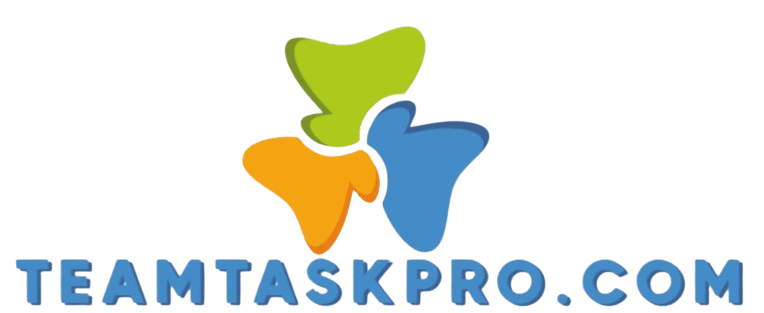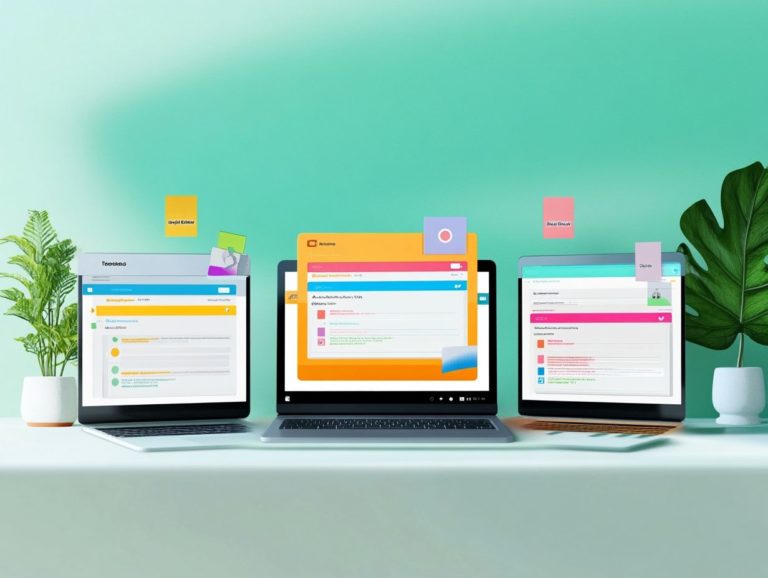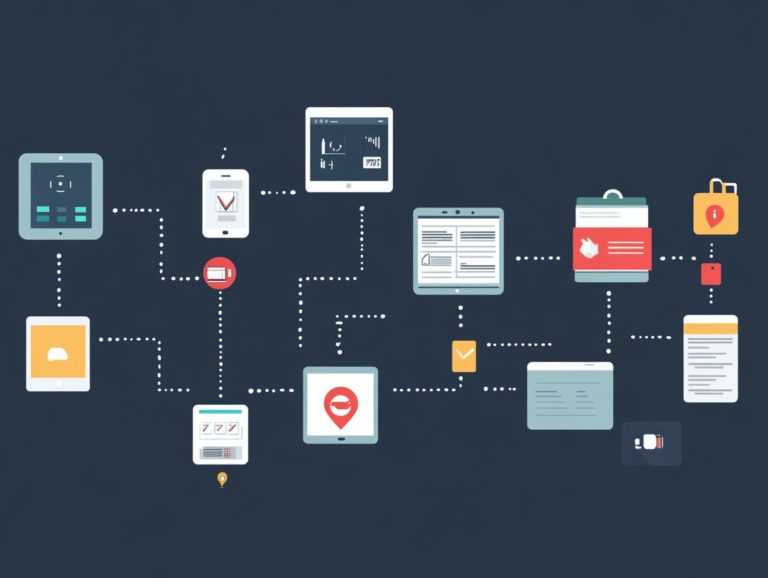how to migrate to a new task management tool
In today s fast-paced work environment, mastering effective task management is essential for achieving your team s goals and boosting productivity.
As organizations evolve, the demand for advanced tools becomes clear. You may want to think about switching to a new task management solution.
This article explores the benefits of making this change. You’ll find a roadmap for the migration process.
Discover best practices that ensure a smooth transition, helping your team make the most of the new tool.
Contents
- Key Takeaways:
- Benefits of Migrating to a New Task Management Tool
- Steps for Migrating to a New Task Management Tool
- Top Tips for a Smooth Migration
- Frequently Asked Questions
- How do I choose the right task management tool to migrate to?
- What steps should I take before migrating to a new task management tool?
- What data do I need to transfer to the new tool?
- How can I ensure a seamless transition for my team?
- Should I transfer all my data at once or in stages?
- What should I do after the migration is complete?
Key Takeaways:

Switching to a new task management tool can improve features and functionality. This makes your team more efficient.
A modern tool can streamline workflow and collaboration, helping everyone work together seamlessly.
For a successful migration, communicate with your team, provide training, and plan carefully.
What are Task Management Tools?
Task management tools are software that help you organize and track tasks within projects. They streamline workflows and improve how your team operates.
These tools include features like task assignments and project scheduling, designed to help you meet your goals.
With these capabilities, you can boost team engagement and align with your organization’s objectives.
The best tools also offer customizable dashboards. These allow you to see project workflows in real-time, which helps secure team support.
Effective communication is a key feature of these platforms. They enable instant feedback and collaboration, reducing delays and misunderstandings.
Benefits of Migrating to a New Task Management Tool
Switching to a new task management tool can greatly improve your project’s efficiency and client satisfaction.
This migration process involves thorough planning to align with your business goals and enhance operations.
Improved Features and Functionality
Moving to a new task management tool offers numerous benefits, especially enhanced features that address common issues.
These improvements ensure the tools fit well with your project workflows. Strong data mapping lets you visualize tasks and their connections easily.
Task assignments become straightforward, allowing you to delegate efficiently while keeping everyone accountable.
The built-in communication features help your team collaborate effortlessly, making it easy to discuss updates or challenges.
These enhancements strengthen your project management efforts by providing key metrics to track progress and identify improvement areas.
Ready to improve your team’s workflow? Start evaluating your task management options today!
Streamlined Workflow and Collaboration
A streamlined workflow is essential for fostering collaboration among your project teams. Migrating to a new task management tool can elevate this aspect significantly.
By adopting a structured approach to project management, you can better manage tasks. This ensures alignment with project objectives and accountability structures.
This method enhances communication and facilitates regular check-ins and meetings, keeping everyone on the same page.
Incorporating feedback loops encourages engagement among team members. They can share insights and suggestions that drive continual improvement.
Maintaining project transparency through clear task assignments builds trust. It ultimately boosts productivity and success.
Exciting collaboration tools provide a clear path that connects everyone s efforts with collective goals, reinforcing a unified direction toward project completion.
Steps for Migrating to a New Task Management Tool

Successfully migrating to a new task management tool requires a systematic approach. Learning how to set up a task management tool with clearly defined steps ensures a smooth transition that aligns with your business objectives.
Start by assessing your current needs. Thoroughly research available tools and engage in meticulous planning to sidestep potential migration issues.
Assessing Your Current Needs and Requirements
Assessing current needs is crucial for a successful migration. This directly impacts how well your projects will work.
Understanding your team’s unique needs helps you select a tool that fits perfectly with your project goals. Engaging team members through feedback sessions ensures diverse perspectives are heard.
Facilitating open discussions uncovers insights that inform project workflows. Keeping user accounts active allows everyone to contribute to the analysis.
This collaborative approach enables decision-makers to choose a tool that meets today s demands and adapts to future challenges.
Researching and Comparing Different Tools
Researching different task management tools helps you make informed decisions during migration. Evaluate features, usability, and integration capabilities to ensure they align with your operations.
Consider key criteria such as functionality and user experience. The tools should be easy to use for team members at all skill levels.
Functionality includes features that support task assignment, progress tracking, and reporting. Assessing the quality of support services is also crucial for effective onboarding.
Focusing on these criteria prepares you to select the best tool for your needs.
Planning and Preparing for the Migration
Planning and preparation are essential for the migration process. This ensures that every team member is aligned and ready to embrace the new task management tool.
Develop a well-structured project schedule. It should clearly outline tasks, responsibilities, and timelines to significantly increase the odds of a successful migration.
Craft a comprehensive migration checklist. This will help you pinpoint essential steps and avoid potential mistakes along the way.
It’s equally important to schedule training sessions for all users. This enables migration leaders to guide the team through the new project tools, fostering confidence and competency.
Establishing clear roles ensures every team member knows what to do. This creates a solid framework for efficient reporting and follow-up.
Together, these components create a cohesive strategy that streamlines the migration journey and nurtures a collaborative atmosphere.
Executing the Migration Process
Executing the migration process requires your careful attention and the commitment of your team. This ensures that every stakeholder remains informed and engaged throughout the transition.
This phase centers on implementing the new task management tool and closely monitoring progress. Address any issues that may arise during the migration.
Effective communication strategies play a pivotal role at this stage. They help clarify expectations and foster collaboration among team members.
Use performance metrics to see how well the new tool meets your goals. This insight will keep the project on track!
Feedback loops are equally essential. They enable your team to adjust strategies based on real-time insights.
This continuous improvement process ensures that any hurdles encountered are swiftly addressed. Ultimately, this leads to the overall success of the project.
Top Tips for a Smooth Migration

Implementing best practices is essential for a successful migration to a new task management tool. This ensures that your transition is seamless and perfectly aligned with your project management goals.
Key best practices include:
- Fostering effective communication with your team
- Providing comprehensive training
- Conducting thorough onboarding sessions to facilitate swift adaptation
Communicating with Team Members
Effective communication with your team is essential for a successful migration to a new task management tool. Establish clear communication channels and nurture a collaborative environment to address concerns and facilitate a smoother transition.
Hold structured meetings that allow for focused discussions on the migration process. This enables team members to voice their opinions and ask questions in real time, ensuring everyone is on the same page.
Encouraging feedback loops can further enhance team buy-in. This creates opportunities for continuous dialogue and clarity around ongoing changes.
Leverage insights from experts who have navigated similar transitions. Their practical advice and best practices can make the process feel far more manageable.
This holistic approach not only fosters engagement but also cultivates a sense of ownership and commitment to the new tool. Start these conversations today to set your team up for success!
Training and Onboarding
Training and onboarding sessions play an important role in your migration journey. They ensure that every team member is equipped with the essential skills to utilize the new task management tool effectively. This training support enhances user experience and significantly contributes to the overall success of your projects.
A diverse blend of training methods can markedly improve retention and mastery of project management tools. Hands-on sessions allow you to engage directly with the software, fostering a deeper understanding of the steps involved in managing a project and enabling real-time problem-solving.
When combined with digital resources such as video tutorials and interactive platforms, these approaches cater to various learning styles. Incorporate collaborative tasks during training to boost team engagement. This sparks open communication and reinforces best practices.
Ultimately, the right mix of these strategies enables your team and streamlines their transition, ensuring a smoother and more efficient adaptation to the new systems.
Testing and Troubleshooting
Testing and troubleshooting are crucial stages in the migration process, enabling you to identify and resolve any issues that may arise as you transition to a new task management tool.
This phase is key to ensuring that the tool functions as intended. It aligns seamlessly with your project management goals and enhances operational efficiency.
By adhering to rigorous testing protocols, you not only improve performance metrics but also create accountability structures that render the migration process more transparent.
Effective troubleshooting demands collaboration among migration leaders who can swiftly pinpoint root causes and implement timely solutions. By cultivating an environment where feedback is welcomed, you enable your team to tackle common migration challenges such as data integrity and user adoption hurdles ensuring a smoother transition and paving the way for long-term success.
Frequently Asked Questions
How do I choose the right task management tool to migrate to?

When selecting a new task management tool, consider your team’s needs, budget, and preferences. Research different options and read reviews to find the best fit for your organization.
What steps should I take before migrating to a new task management tool?
Before making the switch, it s important to map out your current task management process and identify any pain points. Determine your must-have features in a new tool to help ensure a smooth transition.
What data do I need to transfer to the new tool?
The data you will need to migrate will vary depending on the features and customization of your current tool. Typically, you will need to transfer all tasks, projects, deadlines, and any relevant attachments or comments.
How can I ensure a seamless transition for my team?
Communication is key. Involve your team in the decision-making process and provide training on the new tool. Encourage feedback and address any concerns or questions they may have.
Should I transfer all my data at once or in stages?
The best approach depends on the complexity of your current task management system and the size of your team. It may be more manageable to transfer data in stages to ensure accuracy and minimize disruption for your team.
What should I do after the migration is complete?
After the transfer is complete, it s important to test the new tool thoroughly. Gather feedback from your team, make any necessary adjustments, and continue to monitor the effectiveness of the new task management tool.





